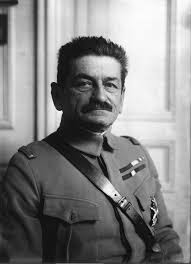By James Patton
 |
| Lt. Raymond Asquith |
Raymond Asquith was born in Hampstead on 6 6 November 1878, the firstborn child and eldest son of Herbert Henry (familiarly known as “H.H.”) Asquith and his wife, the former Helen Melland (1855–1891). H.H., son of a Yorkshire tradesman and orphaned at seven, won a scholarship at Balliol College, Oxford, where he was president of the Oxford Union. In 1876 he became a Lincoln’s Inn barrister and struggled for ten years until he was elected a Member of Parliament (MP). He served as Home Secretary from 1892 to 1895 and when the Liberals returned in 1905 he was made chancellor of the exchequer before becoming prime minister on 5 April 1908, serving until 5 December 1916.
Raymond was twelve years old when his mother died and fifteen when his father married Margot Tennant, a family friend. Raymond didn’t get on well with Margot, feeling that she wasn’t motherly to his younger siblings. He grew distant from his father, partly due to Margot and partly due to a keen sense of competition. He seemed to be determined to outdo his father in everything.
He was educated at Winchester and, like his father, at Balliol College, Oxford, where he was the president of the Oxford Union Debating Society and received a first in 1902. As a graduate he was elected a fellow of the prestigious All Souls College, Oxford, passing what has been called the hardest examination in the world. Although he dabbled in poetry at Oxford, he was called to the bar at Lincoln’s Inn in 1904. Much more successful at the law than his father, he was junior counsel in the North Atlantic Fisheries Arbitration and also in the investigation of the sinking of the Titanic.
In 1907 Raymond married Katherine Horner (1885–1976). This was a socially acceptable match, as her family was landed and wealthy. They would have three children, Helen (1908–2000), Perdita (1910–1996), who became Lady Hylton, and Julian (1916–2011), who in 1928 succeeded to the peerage granted to his grandfather in 1925 as Earl of Oxford and Asquith. Katherine never remarried.
Meanwhile, a political career was envisioned for Raymond, and in 1914 he was tapped to be the next Liberal candidate for the constituency of Derby.
The war intervened, and soon after the onset the Asquith boys volunteered to do their bit (except Anthony, who was 14). Raymond and Cyril (1890–1954) were commissioned in the 16th (County of London) Battalion (Queen’s Westminster Rifles). Raymond later transferred to the 3rd Battalion, Grenadier Guards, on 14 August 1915.
Cyril stayed with the Westminsters and ended the war as a captain. Arthur (1883–1939) was commissioned in the navy and soon assigned to the Royal Naval Division. This may not have been what he intended, but he made the most of it; he was awarded three Distinguished Service Orders, was wounded four times, and ended the war as a one-legged brigadier serving in the Ministry of Munitions. Herbert (1881–1947) a minor poet, was commissioned in the Royal Artillery.
 |
| Wounded Men at Ginchy, September 1916 |
On 15 September 1916, during the Battle of Flers-Courcelette, Raymond’s outfit, the 3rd Grenadier Guards, led the attack on Lesbeoufs that was launched from Ginchy. Quoting from the War Diaries:
The bombardment overnight on the German positions opposite was continuous. At 6.20am, zero hour, the creeping barrage came down and the two Guards brigades moved forward…
Raymond Asquith was leading the first half of 4 Company, 3rd Grenadier Guards, which went over the top at zero hour from a spot not 500 yards outside the hole in the ground that was once Ginchy. Taken by the 16th (Irish) Division on 9 September, German counter-attacks had retaken the north-east corner until the night of 13/14 September when 2nd Grenadier Guards had pushed them out...
The Guards Division were faced by the Serpentine Trench ahead of them and The Triangle on their right, both protected by thick bands of barbed wire and machine guns from the Quadrilateral that swept the ground in front of them…
Lieutenant Asquith, leading 13 and 14 platoons of No.4 Company was shot and fatally wounded in the chest in the first wave, soon after leaving the trench. The story goes that he urged to be propped up, smoking cigarettes, so that he could encourage his men as they continued into the fight; he died later that day.
This attack was led by three tanks. Only one was of any help. From the History of the Guards:
 |
| Asquith's Grave, Guillemont Road Cemetery |
The remaining tanks wandered about in various directions and are reported to have done a certain amount of useful fighting on their own account either in the area of the Guards Division or in that of the 6th Division, but they certainly failed on this occasion to carry out their main task and were of no help to the infantry in the subduing of machine-gun fire.
~ Report of Major-General G. P. Fielding, 19 September 1916
Also in killed in this action were a serving MP, G.V. Bearing, and the son of another MP, David Henderson.
Raymond is buried in CWGC Guillemont Road Cemetery [Plot I. Row B, Grave 3], where his headstone is inscribed "Small time but in that small most greatly lived this star of England," a concluding line from Shakespeare's Henry V. He is memorialized at Amiens Cathedral and also in St. Andrews Church in Mells, Somerset, his wife’s family parish. The latter was designed by Sir Edwin Lutyens, a family friend, and is the smallest memorial ever designed by Lutyens, who also designed the Thiepval Memorial, the India Gate, and the Whitehall Cenotaph, among many others.























































